http://dataunion.org/20714.html
感谢于建民的投稿,转载请注明出处:数盟社区
机器学习的一个重要组成部分是如何寻找最优参数解。本文就常见寻优方法进行总结,并给出简单python2.7实现,可能文章有点长,大家耐心些。
寻找最优参数解,就是在一块参数区域上,去找到满足约束条件的那组参数。形象描述,比如代价函数是个碗状的,那我们就是去找最底部(代价最小)的那个地方的对应的参数值作为最优解。那么,如何找到那个底部的最优参数解呢,如何由一个初始值,一步一步地接近该最优解呢。寻优方法,提供了靠近最优解的方法,其中涉及到的核心点,无外乎两点:靠近最优解的方向和步幅(每步的长度)。
最优化,分为线性最优化理论和非线性最优化理论。其中线性最优化又称线性规划。目标函数和约束条件的表达是线性的,Y=αX;非线性最优化理论,是非线性的。其中包括梯度法,牛顿法,拟牛顿法(DFP/BFGS),约束变尺度(SQP),Lagrange乘子法,信赖域法等。
算法原理及简单推导
最速下降法(梯度下降法)
借助梯度,找到下降最快的方向,大小为最大变化率。
![]()
梯度:是方向导数中,变化最大的那个方向导数。
梯度方向:标量场中增长最快的方向。
梯度大小:最大变化率。
更新:沿着梯度的负向,更新参数(靠近最优解)。
*********************************************

*********************************************
梯度下降法
优点:方便直观,便于理解。
缺点:下降速度慢,有时参数会震荡在最优解附近无法终止。
牛顿下降法
牛顿下降法,是通过泰勒展开到二阶,推到出参数更新公式的。

调整了参数更新的方向和大小(牛顿方向)。
*********************************************

*********************************************
牛顿下降法
优点:对于正定二次函数,迭代一次,就可以得到极小值点。下降的目的性更强。
缺点:要求二阶可微分;收敛性对初始点的选取依赖性很大;每次迭代都要计算Hessian矩阵,计算量大;计算Dk时,方程组有时奇异或者病态,无法求解Dk或者Dk不是下降方向。
阻尼牛顿法
这是对牛顿法的改进,在求新的迭代点时,以Dk作为搜索方向,进行一维搜索,求步长控制量α,
*********************************************

*********************************************
阻尼牛顿法
优点:修改了下降方向,使得始终朝着下降的方向迭代。
缺点:与牛顿法一样。
一维搜索方法简介
一维无约束优化问题minF(α),求解F(α)的极小值和极大值的数值迭代方法,即为一维搜索方法。常用的方法包括:试探法(黄金分割法,fibonacci方法,平分法,格点法);插值法(牛顿法,抛物线法)。
(1)确定最优解所在区间[a,b] (进退法)
思想:从初始点α0开始,以步长h前进或者后退,试出三个点f(α0+h),f(α0),f(α0−h),满足大,小,大规律。
*********************************************

*********************************************
(2)在[a, b]内,找到极小值(黄金分割法和平分法)
*********************************************


*********************************************
思考:如何在实际应用中,选择[a, b],函数f是什么样子的?这些问题需要讨论。整个优化的目标是:找到最优θ,使得代价CostJ最小。故此,f=CostJ。
拟牛顿法 – DFP法
由于牛顿法计算二阶导数,计算量大,故此用其他方法(一阶导数)估计Hessian矩阵的逆。f(x)在Xk+1处,展开成二阶泰勒级数。

根据H的构造函数不同,分为不同的拟牛顿方法,下面为DFP方法:

*********************************************

*********************************************
拟牛顿法DFP:
优点:减少了二阶计算,运算量大大降低。
拟牛顿法 – BFGS法
若构造函数如下,则为BFGS法。

*********************************************

*********************************************
拟牛顿法是无约束最优化方法中最有效的一类算法。
算法的Python实现代码
Python2.7需要安装pandas, numpy, scipy, matplotlib。
下面给出Windows7下exe方式按照上面模块的简单方法。
numpy–http://sourceforge.net/projects/numpy/files/ –这里面也可以找到较新的scipy –
scipy–http://download.csdn.net/detail/caanyee/8241305
pandas-https://pypi.python.org/packages/2.7/p/pandas/pandas-0.12.0.win32-py2.7.exe#md5=80b0b9b891842ef4bdf451ac07b368e5
test.py
# coding = utf-8 ''' time: 2015.06.03 author: yujianmin objection: BGD / SGD / mini-batch GD / QNGD / DFP / BFGS 实现了批量梯度下降、单个梯度下降; 最速下降法、牛顿下降法、阻尼牛顿法、拟牛顿DFP和BFGS ''' import pandas as pd import numpy as np import scipy as sp import matplotlib.pyplot as plt data = pd.read_csv("C:\\Users\\yujianmin\\Desktop\\python\\arraydataR.csv") print(data.ix[1:5, :]) dataArray = np.array(data) ''' x = dataArray[:, 0] y = dataArray[:, 1] plt.plot(x, y, 'o') plt.title('data is like this') plt.xlabel('x feature') plt.ylabel('y label') plt.show() ''' def Myfunction_BGD(data, alpha, numIter, eplise): ''' Batch Gradient Descent :type data: array :param data: contain x and y(label) :type step: int/float numeric :param step: length of step when update the theta ''' nCol = data.shape[1]-1 nRow = data.shape[0] print nCol print nRow x = data[:, :nCol] print x[1:5, :] z = np.ones(nRow).reshape(nRow, 1) x = np.hstack((z, x)) ## vstack merge like rbind in R; hstack like cbind in R; y = data[:, (nCol)].reshape(nRow, 1) #theta = np.random.random(nCol+1).reshape(nCol+1, 1) theta = np.ones(nCol+1).reshape(nCol+1, 1) i = 0 costJ = [] #eplise = 0.4 while i < numIter: H = np.dot(x,theta) J = (np.sum((y-H)**2))/(2*nRow) print('Itering %d ;cost is:%f' %(i+1,J)) costJ.append(J) Gradient = (np.dot(np.transpose(y-H),x))/nRow Gradient = Gradient.reshape(nCol+1, 1) if np.sum(np.fabs(Gradient))<= eplise: return theta, costJ else: ## update theta = theta + alpha * Gradient i = i + 1 return theta, costJ def Myfunction_SGD(data, alpha, numIter, eplise): ''' Stochastic Gradient Descent :type data: array :param data: contain x and y(label) :type step: int/float numeric :param step: length of step when update the theta ''' nCol = data.shape[1]-1 nRow = data.shape[0] print nCol print nRow x = data[:, :nCol] print x[1:5, :] z = np.ones(nRow).reshape(nRow, 1) x = np.hstack((z, x)) ## vstack merge like rbind in R; hstack like cbind in R; y = data[:, (nCol)].reshape(nRow, 1) #theta = np.random.random(nCol+1).reshape(nCol+1, 1) theta = np.ones(nCol+1).reshape(nCol+1, 1) Loop = 0 costJ = [] while Loop <numIter: H = np.dot(x,theta) J = np.sum((y-H)**2)/(2*nRow) print('Itering %d ;cost is:%f' %(Loop+1,J)) costJ.append(J) i = 0 while i <nRow: Gradient = (y[i] - np.dot(x[i], theta)) * x[i] Gradient = Gradient.reshape(nCol+1, 1) theta = theta + alpha * Gradient i = i + 1 #eplise = 0.4 Gradient = (np.dot(np.transpose(y-H),x))/nRow if np.sum(np.fabs(Gradient))<= eplise: return theta, costJ Loop = Loop + 1 return theta, costJ def Myfunction_NGD1(data, alpha, numIter, eplise): ''' Newton Gradient Descent -- theta := theta - alpha*[f'']^(-1)*f' :type data: array :param data: contain x and y(label) :type step: int/float numeric :param step: length of step when update the theta :reference:http://www.doc88.com/p-145660070193.html :hessian = transpos(x) * x ''' nCol = data.shape[1]-1 nRow = data.shape[0] print nCol print nRow x = data[:, :nCol] print x[1:5, :] z = np.ones(nRow).reshape(nRow, 1) x = np.hstack((z, x)) ## vstack merge like rbind in R; hstack like cbind in R; y = data[:, (nCol)].reshape(nRow, 1) #theta = np.random.random(nCol+1).reshape(nCol+1, 1) theta = np.ones(nCol+1).reshape(nCol+1, 1) i = 0 costJ = [] while i < numIter: H = np.dot(x,theta) J = (np.sum((y-H)**2))/(2*nRow) ## update print('Itering %d ;cost is:%f' %(i+1,J)) costJ.append(J) Gradient = (np.dot(np.transpose(y-H),x))/nRow Gradient = Gradient.reshape(nCol+1, 1) #eplise = 0.4 if np.sum(np.fabs(Gradient))<=eplise: return theta, costJ Hessian = np.dot(np.transpose(x), x)/nRow theta = theta + alpha * np.dot(np.linalg.inv(Hessian), Gradient) #theta = theta + np.dot(np.linalg.inv(Hessian), Gradient) i = i + 1 return theta, costJ def Myfunction_NGD2(data, alpha, numIter, eplise): ''' Newton Gradient Descent -- theta := theta - [f'']^(-1)*f' :type data: array :param data: contain x and y(label) :type step: int/float numeric :param step: length of step when update the theta :reference:http://www.doc88.com/p-145660070193.html :hessian = transpos(x) * x ''' nCol = data.shape[1]-1 nRow = data.shape[0] print nCol print nRow x = data[:, :nCol] print x[1:5, :] z = np.ones(nRow).reshape(nRow, 1) x = np.hstack((z, x)) ## vstack merge like rbind in R; hstack like cbind in R; y = data[:, (nCol)].reshape(nRow, 1) #theta = np.random.random(nCol+1).reshape(nCol+1, 1) theta = np.ones(nCol+1).reshape(nCol+1, 1) i = 0 costJ = [] while i < numIter: H = np.dot(x,theta) J = (np.sum((y-H)**2))/(2*nRow) ## update print('Itering %d ;cost is:%f' %(i+1,J)) costJ.append(J) Gradient = (np.dot(np.transpose(y-H),x))/nRow Gradient = Gradient.reshape(nCol+1, 1) #eplise = 0.4 if np.sum(np.fabs(Gradient)) <= eplise: return theta, costJ Hessian = np.dot(np.transpose(x), x)/nRow theta = theta + np.dot(np.linalg.inv(Hessian), Gradient) i = i + 1 return theta, costJ def Myfunction_QNGD(data, alpha, numIter, eplise): ''' Newton Gradient Descent -- theta := theta - alpha* [f'']^(-1)*f'-- alpha is search by ForwardAndBack method and huang jin fen ge :type data: array :param data: contain x and y(label) :type step: int/float numeric :param step: length of step when update the theta :reference:http://www.doc88.com/p-145660070193.html :hessian = transpos(x) * x ''' nCol = data.shape[1]-1 nRow = data.shape[0] print nCol print nRow x = data[:, :nCol] print x[1:5, :] z = np.ones(nRow).reshape(nRow, 1) x = np.hstack((z, x)) ## vstack merge like rbind in R; hstack like cbind in R; y = data[:, (nCol)].reshape(nRow, 1) #theta = np.random.random(nCol+1).reshape(nCol+1, 1) theta = np.ones(nCol+1).reshape(nCol+1, 1) i = 0 costJ = [] #eplise = 0.4 while i < numIter: H = np.dot(x,theta) J = (np.sum((y-H)**2))/(2*nRow) ## update print('Itering %d ;cost is:%f' %(i+1,J)) costJ.append(J) Gradient = (np.dot(np.transpose(y-H),x))/nRow Gradient = Gradient.reshape(nCol+1, 1) if np.sum(np.fabs(Gradient))<= eplise: return theta, costJ else: Hessian = np.dot(np.transpose(x), x)/nRow Dk = - np.dot(np.linalg.inv(Hessian), Gradient) ## find optimal [a,b] which contain optimal alpha ## optimal alpha lead to min{f(theta + alpha*DK)} alpha0 = 0 h = np.random.random(1) alpha1 = alpha0 alpha2 = alpha0 + h theta1 = theta + alpha1 * Dk theta2 = theta + alpha2 * Dk f1 = (np.sum((y-np.dot(x, theta1))**2))/(2*nRow) f2 = (np.sum((y-np.dot(x, theta2))**2))/(2*nRow) Loop = 1 a = 0 b = 0 while Loop >0: print(' find [a,b] loop is %d' %Loop) Loop = Loop + 1 if f1 > f2: h = 2*h else: h = -h (alpha1, alpha2) = (alpha2, alpha1) (f1, f2) = (f2, f1) alpha3 = alpha2 + h theta3 = theta + alpha3 * Dk f3 = (np.sum((y-np.dot(x, theta3))**2))/(2*nRow) print('f3 - f2 is %f' %(f3-f2)) if f3 > f2: a = min(alpha1, alpha3) b = max(alpha1, alpha3) break if f3 <= f2: alpha1 = alpha2 alpha2 = alpha3 f1 = f2 f2 = f3 ## find optiaml alpha in [a,b] using huang jin fen ge fa e = 0.01 while Loop >0: alpha1 = a + 0.382 * (b - a) alpha2 = a + 0.618 * (b - a) theta1 = theta + alpha1* Dk theta2 = theta + alpha2* Dk f1 = (np.sum((y-np.dot(x, theta1))**2))/(2*nRow) f2 = (np.sum((y-np.dot(x, theta2))**2))/(2*nRow) if f1 > f2: a = alpha1 if f1< f2: b = alpha2 if np.fabs(a-b) <= e: alpha = (a+b)/2 break print('optimal alpha is %f' % alpha) theta = theta + alpha * Dk i = i + 1 return theta, costJ def Myfunction_DFP2(data, alpha, numIter, eplise): ''' DFP -- theta := theta + alpha * Dk --alpha is searched by huangjin method --satisfied argmin{f(theta+alpha*Dk)}## :type data: array :param data: contain x and y(label) :type step: int/float numeric :param step: length of step when update the theta :reference:http://blog.pfan.cn/miaowei/52925.html :reference:http://max.book118.com/html/2012/1025/3119007.shtm ## important ## :hessian is estimated by DFP method. ''' nCol = data.shape[1]-1 nRow = data.shape[0] print nCol print nRow x = data[:, :nCol] print x[1:5, :] z = np.ones(nRow).reshape(nRow, 1) x = np.hstack((z, x)) ## vstack merge like rbind in R; hstack like cbind in R; y = data[:, (nCol)].reshape(nRow, 1) #theta = np.random.random(nCol+1).reshape(nCol+1, 1) theta = np.ones(nCol+1).reshape(nCol+1, 1) i = 0 costJ = [] Hessian = np.eye(nCol+1) H = np.dot(x,theta) J = (np.sum((y-H)**2))/(2*nRow) #costJ.append(J) Gradient = (np.dot(np.transpose(y-H),x))/nRow Gradient = Gradient.reshape(nCol+1, 1) Dk = - Gradient #eplise = 0.4 while i < numIter: if(np.sum(np.fabs(Dk)) <= eplise ): ## stop condition ## return theta, costJ else: ## find alpha that min f(thetaK + alpha * Dk) ## find optimal [a,b] which contain optimal alpha ## optimal alpha lead to min{f(theta + alpha*DK)} alpha0 = 0 h = np.random.random(1) alpha1 = alpha0 alpha2 = alpha0 + h theta1 = theta + alpha1 * Dk theta2 = theta + alpha2 * Dk f1 = (np.sum((y-np.dot(x, theta1))**2))/(2*nRow) f2 = (np.sum((y-np.dot(x, theta2))**2))/(2*nRow) Loop = 1 a = 0 b = 0 while Loop >0: print(' find [a,b] loop is %d' %Loop) Loop = Loop + 1 if f1 > f2: h = 2*h else: h = -h (alpha1, alpha2) = (alpha2, alpha1) (f1, f2) = (f2, f1) alpha3 = alpha2 + h theta3 = theta + alpha3 * Dk f3 = (np.sum((y-np.dot(x, theta3))**2))/(2*nRow) print('f3 - f2 is %f' %(f3-f2)) if f3 > f2: a = min(alpha1, alpha3) b = max(alpha1, alpha3) break if f3 <= f2: alpha1 = alpha2 alpha2 = alpha3 f1 = f2 f2 = f3 ## find optiaml alpha in [a,b] using huang jin fen ge fa e = 0.01 while Loop >0: alpha1 = a + 0.382 * (b - a) alpha2 = a + 0.618 * (b - a) theta1 = theta + alpha1* Dk theta2 = theta + alpha2* Dk f1 = (np.sum((y-np.dot(x, theta1))**2))/(2*nRow) f2 = (np.sum((y-np.dot(x, theta2))**2))/(2*nRow) if f1 > f2: a = alpha1 if f1< f2: b = alpha2 if np.fabs(a-b) <= e: alpha = (a+b)/2 break print('optimal alpha is %f' % alpha) theta_old = theta theta = theta + alpha * Dk ## update the Hessian matrix ## H = np.dot(x,theta) J = (np.sum((y-H)**2))/(2*nRow) ## update print('Itering %d ;cost is:%f' %(i+1,J)) costJ.append(J) # here to estimate Hessian'inv # # sk = ThetaNew - ThetaOld = alpha * inv(H) * Gradient sk = theta - theta_old #yk = DelX(k+1) - DelX(k) DelXK = - (np.dot(np.transpose(y-np.dot(x, theta)),x))/nRow DelXk = - (np.dot(np.transpose(y-np.dot(x, theta_old)),x))/nRow yk = (DelXK - DelXk).reshape(nCol+1, 1) #z1 = (sk * sk') # a matrix #z2 = (sk' * yk) # a value z1 = sk * np.transpose(sk) z2 = np.dot(np.transpose(sk),yk) #z3 = (H * yk * yk' * H) # a matrix #z4 = (yk' * H * yk) # a value z3 = np.dot(np.dot(np.dot(Hessian, yk), np.transpose(yk)), Hessian) z4 = np.dot(np.dot(np.transpose(yk), Hessian),yk) DHessian = z1/z2 - z3/z4 Hessian = Hessian + DHessian Dk = - np.dot(Hessian, DelXK.reshape(nCol+1,1)) i = i + 1 return theta, costJ def Myfunction_DFP1(data, alpha, numIter, eplise): ''' DFP -- theta := theta + alpha * Dk alpha is fixed ## :type data: array :param data: contain x and y(label) :type step: int/float numeric :param step: length of step when update the theta :reference:http://blog.pfan.cn/miaowei/52925.html :reference:http://max.book118.com/html/2012/1025/3119007.shtm ## important ## :hessian is estimated by DFP method. ''' nCol = data.shape[1]-1 nRow = data.shape[0] print nCol print nRow x = data[:, :nCol] print x[1:5, :] z = np.ones(nRow).reshape(nRow, 1) x = np.hstack((z, x)) ## vstack merge like rbind in R; hstack like cbind in R; y = data[:, (nCol)].reshape(nRow, 1) #theta = np.random.random(nCol+1).reshape(nCol+1, 1) theta = np.ones(nCol+1).reshape(nCol+1, 1) i = 0 costJ = [] Hessian = np.eye(nCol+1) H = np.dot(x,theta) J = (np.sum((y-H)**2))/(2*nRow) #costJ.append(J) Gradient = (np.dot(np.transpose(y-H),x))/nRow Gradient = Gradient.reshape(nCol+1, 1) Dk = - Gradient #eplise = 0.4 while i < numIter: if(np.sum(np.fabs(Dk)) <= eplise ): ## stop condition ## return theta, costJ else: ## find alpha that min f(thetaK + alpha * Dk) ## here for simple alpha is parameter 'alpha' alpha = alpha theta_old = theta theta = theta + alpha * Dk ## update the Hessian matrix ## H = np.dot(x,theta) J = (np.sum((y-H)**2))/(2*nRow) ## update print('Itering %d ;cost is:%f' %(i+1,J)) costJ.append(J) # here to estimate Hessian'inv # # sk = ThetaNew - ThetaOld = alpha * inv(H) * Gradient sk = theta - theta_old #yk = DelX(k+1) - DelX(k) DelXK = - (np.dot(np.transpose(y-np.dot(x, theta)),x))/nRow DelXk = - (np.dot(np.transpose(y-np.dot(x, theta_old)),x))/nRow yk = (DelXK - DelXk).reshape(nCol+1, 1) #z1 = (sk * sk') # a matrix #z2 = (sk' * yk) # a value z1 = sk * np.transpose(sk) z2 = np.dot(np.transpose(sk),yk) #z3 = (H * yk * yk' * H) # a matrix #z4 = (yk' * H * yk) # a value z3 = np.dot(np.dot(np.dot(Hessian, yk), np.transpose(yk)), Hessian) z4 = np.dot(np.dot(np.transpose(yk), Hessian),yk) DHessian = z1/z2 - z3/z4 Hessian = Hessian + DHessian Dk = - np.dot(Hessian, DelXK.reshape(nCol+1,1)) i = i + 1 return theta, costJ def Myfunction_BFGS1(data, alpha, numIter, eplise): ''' BFGS :type data: array :param data: contain x and y(label) :type step: int/float numeric :param step: length of step when update the theta :reference:http://blog.pfan.cn/miaowei/52925.html :reference:http://max.book118.com/html/2012/1025/3119007.shtm ## important ## :hessian is estimated by BFGS method. ''' nCol = data.shape[1]-1 nRow = data.shape[0] print nCol print nRow x = data[:, :nCol] print x[1:5, :] z = np.ones(nRow).reshape(nRow, 1) x = np.hstack((z, x)) ## vstack merge like rbind in R; hstack like cbind in R; y = data[:, (nCol)].reshape(nRow, 1) #theta = np.random.random(nCol+1).reshape(nCol+1, 1) theta = np.ones(nCol+1).reshape(nCol+1, 1) i = 0 costJ = [] Hessian = np.eye(nCol+1) H = np.dot(x,theta) J = (np.sum((y-H)**2))/(2*nRow) #costJ.append(J) Gradient = (np.dot(np.transpose(y-H),x))/nRow Gradient = Gradient.reshape(nCol+1, 1) Dk = - Gradient #eplise = 0.4 while i < numIter: if(np.sum(np.fabs(Dk)) <= eplise ): ## stop condition ## return theta, costJ else: ## find alpha that min J(thetaK + alpha * Dk) ## here for simple alpha is parameter 'alpha' alpha = alpha theta_old = theta theta = theta + alpha * Dk ## update the Hessian matrix ## H = np.dot(x,theta) J = (np.sum((y-H)**2))/(2*nRow) ## update print('Itering %d ;cost is:%f' %(i+1,J)) costJ.append(J) # here to estimate Hessian # # sk = ThetaNew - ThetaOld = alpha * inv(H) * Gradient sk = theta - theta_old #yk = DelX(k+1) - DelX(k) DelXK = - (np.dot(np.transpose(y-np.dot(x, theta)),x))/nRow DelXk = - (np.dot(np.transpose(y-np.dot(x, theta_old)),x))/nRow yk = (DelXK - DelXk).reshape(nCol+1, 1) #z1 = yk' * H * yk # a value #z2 = (sk' * yk) # a value z1 = np.dot(np.dot(np.transpose(yk), Hessian), yk) z2 = np.dot(np.transpose(sk),yk) #z3 = sk * sk' # a matrix #z4 = sk * yk' * H # a matrix z3 = np.dot(sk, np.transpose(sk)) z4 = np.dot(np.dot(sk, np.transpose(yk)), Hessian) DHessian = (1+z1/z2) * (z3/z2) - z4/z2 Hessian = Hessian + DHessian Dk = - np.dot(Hessian, DelXK.reshape(nCol+1,1)) i = i + 1 return theta, costJ def Myfunction_BFGS2(data, alpha, numIter, eplise): ''' BFGS :type data: array :param data: contain x and y(label) :type step: int/float numeric :param step: length of step when update the theta :reference:http://blog.pfan.cn/miaowei/52925.html :reference:http://max.book118.com/html/2012/1025/3119007.shtm ## important ## :hessian is estimated by BFGS method. ''' nCol = data.shape[1]-1 nRow = data.shape[0] print nCol print nRow x = data[:, :nCol] print x[1:5, :] z = np.ones(nRow).reshape(nRow, 1) x = np.hstack((z, x)) ## vstack merge like rbind in R; hstack like cbind in R; y = data[:, (nCol)].reshape(nRow, 1) #theta = np.random.random(nCol+1).reshape(nCol+1, 1) theta = np.ones(nCol+1).reshape(nCol+1, 1) i = 0 costJ = [] Hessian = np.eye(nCol+1) H = np.dot(x,theta) J = (np.sum((y-H)**2))/(2*nRow) #costJ.append(J) Gradient = (np.dot(np.transpose(y-H),x))/nRow Gradient = Gradient.reshape(nCol+1, 1) Dk = - Gradient #eplise = 0.4 while i < numIter: if(np.sum(np.fabs(Dk)) <= eplise ): ## stop condition ## return theta, costJ else: ## find alpha that min J(thetaK + alpha * Dk) alpha = alpha ## find optimal [a,b] which contain optimal alpha ## optimal alpha lead to min{f(theta + alpha*DK)} ''' alpha0 = 0 h = np.random.random(1) alpha1 = alpha0 alpha2 = alpha0 + h theta1 = theta + alpha1 * Dk theta2 = theta + alpha2 * Dk f1 = (np.sum((y-np.dot(x, theta1))**2))/(2*nRow) f2 = (np.sum((y-np.dot(x, theta2))**2))/(2*nRow) Loop = 1 a = 0 b = 0 while Loop >0: print(' find [a,b] loop is %d' %Loop) Loop = Loop + 1 if f1 > f2: h = 2*h else: h = -h (alpha1, alpha2) = (alpha2, alpha1) (f1, f2) = (f2, f1) alpha3 = alpha2 + h theta3 = theta + alpha3 * Dk f3 = (np.sum((y-np.dot(x, theta3))**2))/(2*nRow) print('f3 - f2 is %f' %(f3-f2)) if f3 > f2: a = min(alpha1, alpha3) b = max(alpha1, alpha3) break if f3 <= f2: alpha1 = alpha2 alpha2 = alpha3 f1 = f2 f2 = f3 ## find optiaml alpha in [a,b] using huang jin fen ge fa e = 0.01 while Loop >0: alpha1 = a + 0.382 * (b - a) alpha2 = a + 0.618 * (b - a) theta1 = theta + alpha1* Dk theta2 = theta + alpha2* Dk f1 = (np.sum((y-np.dot(x, theta1))**2))/(2*nRow) f2 = (np.sum((y-np.dot(x, theta2))**2))/(2*nRow) if f1 > f2: a = alpha1 if f1< f2: b = alpha2 if np.fabs(a-b) <= e: alpha = (a+b)/2 break print('optimal alpha is %f' % alpha) ''' ## Get Dk and update Hessian theta_old = theta theta = theta + alpha * Dk ## update the Hessian matrix ## H = np.dot(x,theta) J = (np.sum((y-H)**2))/(2*nRow) ## update print('Itering %d ;cost is:%f' %(i+1,J)) costJ.append(J) # here to estimate Hessian # # sk = ThetaNew - ThetaOld = alpha * inv(H) * Gradient sk = theta - theta_old #yk = DelX(k+1) - DelX(k) DelXK = - (np.dot(np.transpose(y-np.dot(x, theta)),x))/nRow DelXk = - (np.dot(np.transpose(y-np.dot(x, theta_old)),x))/nRow yk = (DelXK - DelXk).reshape(nCol+1, 1) #z1 = yk' * H * yk # a value #z2 = (sk' * yk) # a value z1 = np.dot(np.dot(np.transpose(yk), Hessian), yk) z2 = np.dot(np.transpose(sk),yk) #z3 = sk * sk' # a matrix #z4 = sk * yk' * H # a matrix z3 = np.dot(sk, np.transpose(sk)) z4 = np.dot(np.dot(sk, np.transpose(yk)), Hessian) DHessian = (1+z1/z2) * (z3/z2) - z4/z2 Hessian = Hessian + DHessian Dk = - np.dot(Hessian, DelXK.reshape(nCol+1,1)) i = i + 1 return theta, costJ ## test ## num = 10000 #theta, costJ = Myfunction_BGD(dataArray, alpha=0.0005, numIter=num, eplise=0.4) ## #theta, costJ = Myfunction_SGD(dataArray, alpha=0.00005, numIter=num, eplise=0.4) #theta, costJ = Myfunction_NGD1(dataArray, alpha=0.0005, numIter=num, eplise=0.4) ## alpha is fixed ## #theta, costJ = Myfunction_NGD2(dataArray, alpha=0.0005, numIter=num, eplise=0.4) ## alpha is 1 ## #theta, costJ = Myfunction_QNGD(dataArray, alpha=0.0005, numIter=num, eplise=0.4) ## alpha is searched ## #theta, costJ = Myfunction_DFP1(dataArray, alpha=0.0005, numIter=num, eplise=0.4) ## alpha is fixed ## #theta, costJ = Myfunction_DFP2(dataArray, alpha=0.0005, numIter=num, eplise=0.4) ## alpha is searched ## theta, costJ = Myfunction_BFGS1(dataArray, alpha=0.0005, numIter=num, eplise=0.4) ## alpha is fxied ## print theta klen = len(costJ) leng = np.linspace(1, klen, klen) plt.plot(leng, costJ) plt.show()
实验数据和结果展示
数据csv格式
0 28.22401669 1 33.24921693 2 35.82084277 3 36.87096878 4 30.98488531 5 38.78221296 6 38.46753324 7 41.96065845 8 36.82656413 9 35.5081121 10 35.74647181 11 36.17110987 12 37.51165999 13 41.27109257 14 44.03842677 15 48.03001705 16 45.50401843 17 45.02635608 18 51.70574034 19 46.76359881 20 52.6487595 21 48.81383593 22 50.69451254 23 55.54200403 24 54.55639586 25 53.19036223 26 58.89269091 27 54.78884251 28 57.9033951 29 62.21114967 30 64.51025468 31 62.20710537 32 62.94736304 33 60.30447933 34 65.32044406 35 65.82903452 36 66.37872216 37 69.75640553 38 66.02112594 39 65.87119039 40 74.27209751 41 67.57661628 42 73.19444088 43 69.4533117 44 74.91129817 45 71.21187609 46 77.0962545 47 81.95066837 48 78.04636838 49 83.42842526 50 80.40217563 51 78.68650206 52 82.91395215 53 85.09663115 54 88.71540907 55 87.73955 56 89.18654776 57 91.09337441 58 83.95614422 59 93.30683179 60 93.27618596 61 88.07859238 62 89.10667856 63 95.61443666 64 93.39899106 65 94.38258758 66 96.87641802 67 96.87896946 68 97.0094412 69 100.076115 70 104.7619905 71 100.7917093 72 99.85523362 73 106.9018494 74 103.6061063 75 103.4105058 76 106.4304576 77 110.7357249 78 107.0420455 79 107.2834221 80 113.9299496 81 111.2187627 82 116.4100596 83 108.0237256 84 112.7773592 85 117.3464957 86 117.1976807 87 120.0538521 88 114.4584964 89 122.2860022
结果展示
横轴是迭代次数,纵轴是代价
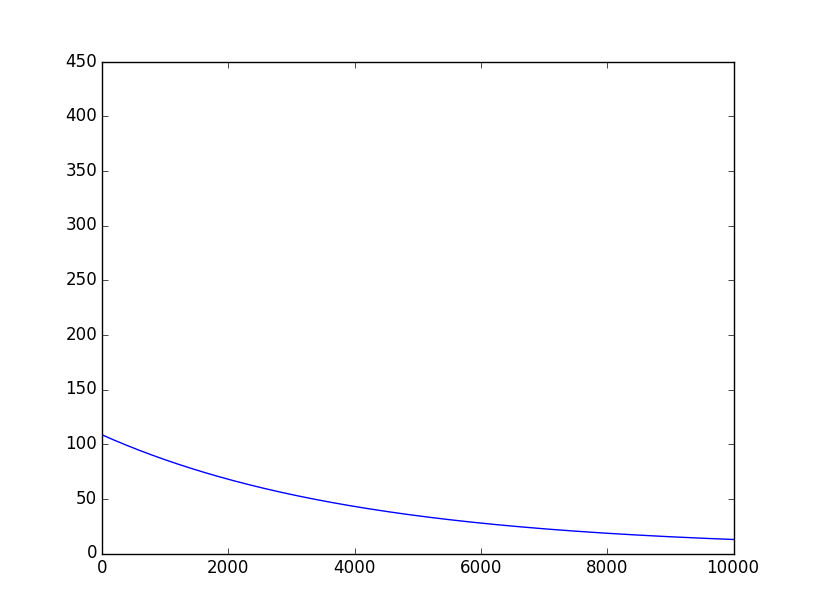
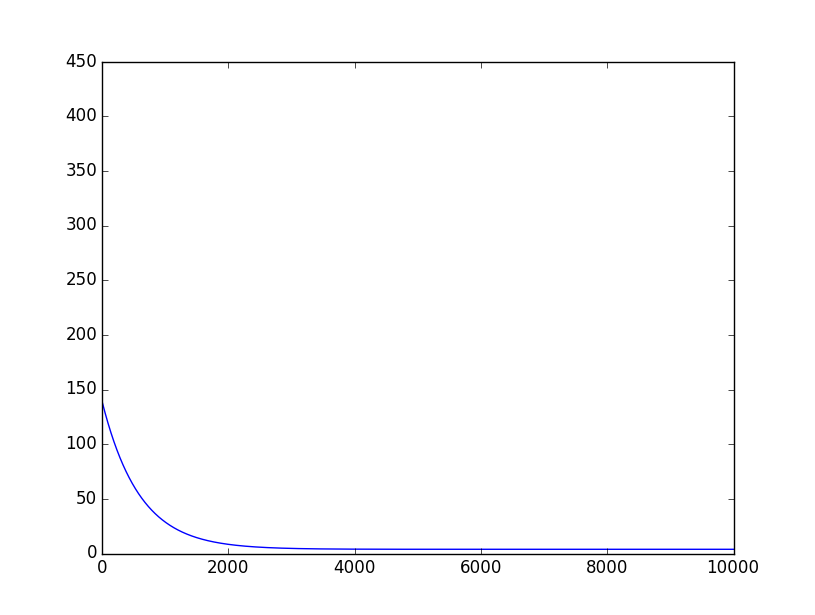

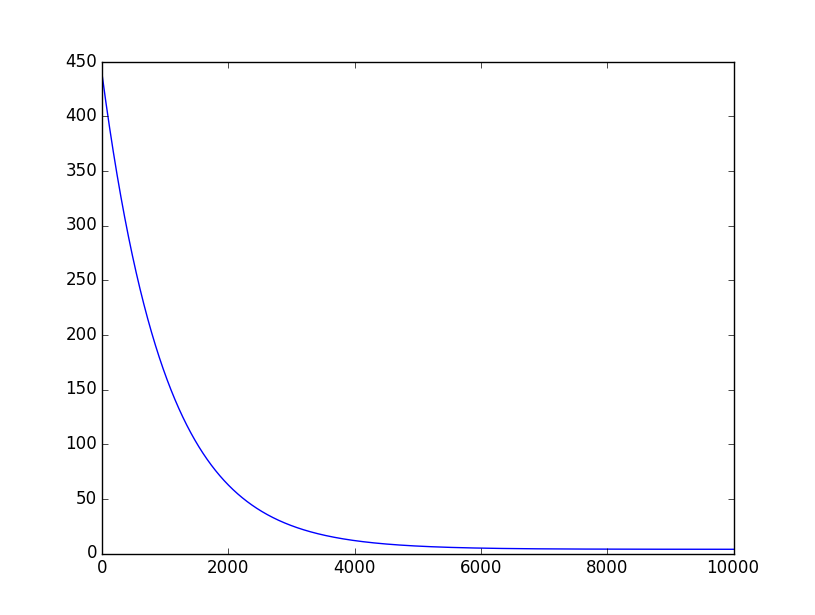
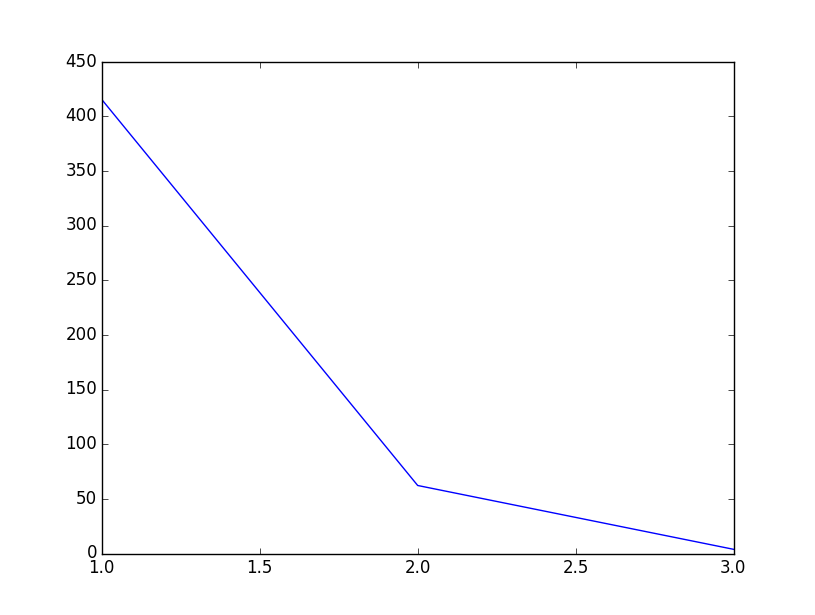
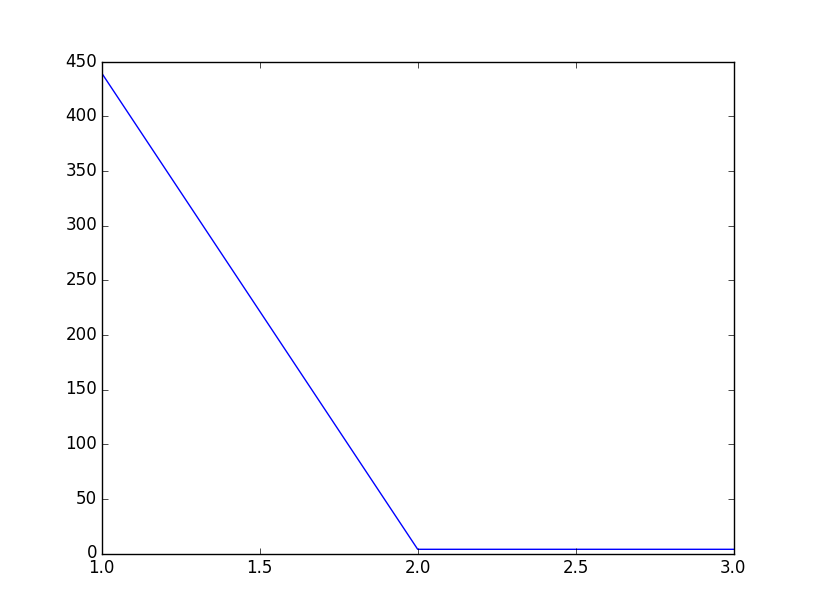
总结
不管什么最优化方法,都是试图去寻找代价下降最快的方向和合适的步幅。






















 1232
1232

 被折叠的 条评论
为什么被折叠?
被折叠的 条评论
为什么被折叠?








